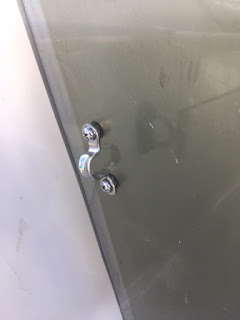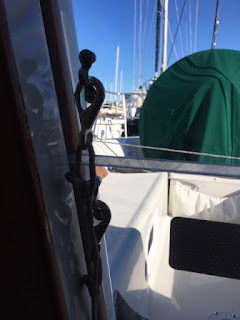This works fine, but there can be times offshore where you want a hatch board in place to keep water out of the cabin, but still be able to easily get in and out of the cabin (which is hard to do with the single hatch board unless you have really long legs). So, a trip to Tap Plastics where I had them fabricate two boards that would fill the space of the current single board. Now we can just put in the bottom half if necessary to keep water out of the cabin, but now can easily step over it to get in and out of the cabin. We've got a padeye on each of the two hatch boards so they can be secured in place.
The additional requirement is that the campanionway hatch needs to be able to be "rigidly secured" capable of being locked and unlocked from either above or below deck. The common way folks do this is to drill a hole through the campanionway hatch and the structure on the side of the campanionway to accept a 3/8" quick release pin. One pin goes above deck and one below. Here's an example from Bob's J92:
I'm not a huge fan of drilling more holes in the boat, but I do have the quick release pins and could still opt for this solution. However, we opted for another approach using a spring loaded slide bolt latch from McMaster-Carr. I got this idea from some of the custom work done by GC Rigging and Composites (of course, their version is made out of carbon fiber). I had Tap Plastics build a 1" spacer block that was fused to the upper hatch board and then bolted on the latch, replaced the chain that came with the latch with some line, and then drilled a hold in the hatch board to the line would extend to the outside (now the latch can be operated from below and above deck). The latch catches on the teak board on the bottom of the companionway hatch and makes it "rigidly secure".
Another safety item off the check list.






No comments:
Post a Comment